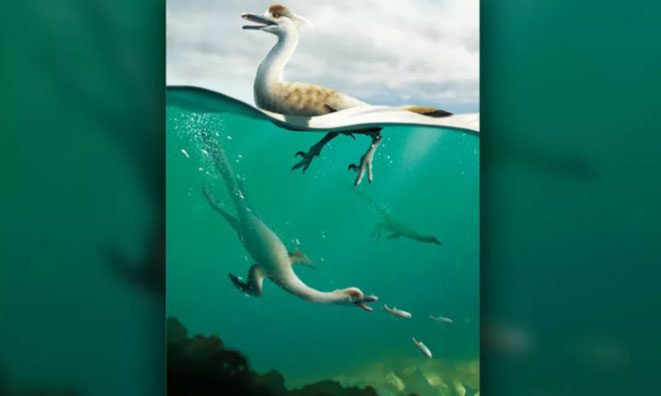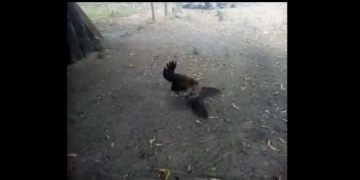A Nearly Complete Fossil Skeleton Reveals the Long-Body Dinosaur Natovenator polydontus, Enabling Easy Movement in Water.
Scientists have discovered a dinosaur species resembling a hybrid between a penguin and a goose with an unusually large number of teeth in the Baruungoyot formation, Gobi Desert, southern Mongolia. The nearly complete fossil skeleton was excavated in 2008 by a research team led by Professor Yuong-Nam Lee, a paleontologist at Seoul National University. The new study was published in the journal Communications Biology on December 1.

Illustration of how the dinosaur Natovenator polydontus swims and dives. (Photo: Yusik Choi)
The fossil skeleton – which includes a skull, spine, one forelimb, and two hind limbs – belongs to a dinosaur that lived during the late Cretaceous period, approximately 66 to 145 million years ago. Lee noted that the specimen is exceptionally well-preserved. Scientists have named the new species Natovenator polydontus, meaning “swimming hunter with many teeth.”
Natovenator polydontus bears a striking resemblance to modern diving birds, such as penguins. However, they are reptiles, not birds. They belong to the theropod dinosaur group – bipedal carnivores. The Tyrannosaurus rex also belongs to this group.
Notably, this is the first theropod dinosaur discovered with a long, streamlined body. This adaptation allows them to walk on land while also moving easily in water. This body shape helps experts gain further insights into their lifestyle and hunting methods.
Based on the shape and similarities of Natovenator polydontus with modern diving birds, the research team believes that they were semi-aquatic predators. “The discovery of a semi-aquatic dinosaur indicates a high level of ecological diversity among dinosaurs. This could change preconceived notions about the lifestyles of dinosaurs,” Lee stated.
The newly discovered dinosaur has ribs that point towards the tail and a long neck similar to that of modern geese. These features would allow them to quickly dive into the water and extend their necks to catch prey.
The Baruungoyot formation is primarily composed of riverbed sediments. Based on this, scientists determined that the newly discovered species lived in freshwater environments rather than near the sea.
They also have an unusually high number of teeth relative to their jaw size. This suggests they may have eaten fish. Fish-eating animals typically have small, sharp teeth to grip and hold fish before swallowing. However, it is also possible they consumed insects. Paleontologists will need to analyze some fossil remains found in their stomachs to better understand their diet.
The nearly complete fossil skeleton of Natovenator polydontus may provide additional information about the evolution of theropod dinosaurs. “The streamlined body offers hydrodynamic advantages while swimming, and the unique rib morphology indicates they were adept swimmers. This provides the first compelling evidence of hydrodynamic body shapes in a non-avian theropod dinosaur,” the research team wrote.
“The new discovery also shows that non-avian theropod dinosaurs had diverse body shapes. Furthermore, Natovenator polydontus helps us better understand the body structure of the dinosaur clade Halszkaraptorines, as they share many common features,” the research team added.





















































